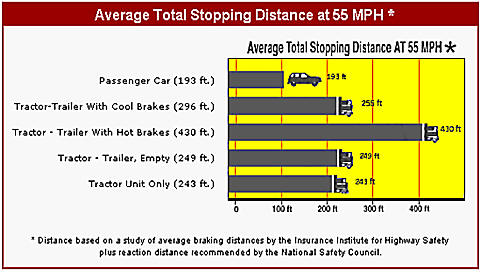Road Safety
Road Safety - It's up to you

Cube Van strikes parked tractor trailer at highway speed
Always use common sense while behind the wheel
|
||
|
General Driving Tips
|
||
|
|
|
|
Avoid blind spots around large vehicles
|
||

Check that the hydraulic dock levelers are properly positioned on the bed of the trailer to allow for safe entry.
This page is intended to help establish safe work practices where trucks are loaded and unloaded.
Loading and unloading of trucks account for a large number of non-driving injuries within the trucking industry each year. Injuries may be minor from improper lifting or manual handling of freight or could be fatal with industrial machinery involved.
Supervisors shall verify that operators are capable and qualified on each type of equipment before allowing the equipment to be operated unsupervised. Operators shall perform a pre-operational check of their equipment, report necessary repairs promptly and not use any equipment that is unsafe.
Provide a safe place where drivers can wait if they are not involved. Drivers should not remain in their cabs if this can be avoided.
No-one should be in the loading/unloading area if they are not needed.
Vehicles must never be overloaded. Overloaded vehicles can become unstable, difficult to steer or be less able to brake.
Always check the floor or deck of the loading area before loading to make sure it is safe. Look out for debris, broken boarding, etc.
Forklifts shall not be driven into and out of trailers at loading docks until such trailers are securely blocked and brakes set.
Employees shall not place any part of their body outside the running lines of the forklift or between mast uprights or other parts of the unit where shear or crushing hazards exist.
Employees shall slow down and sound horn at all locations where visibility is obscured or obstructed. If the load being carried obstructs forward view, the operator shall be required to travel with the load trailing. Avoid sharp turns and sudden starts and stops.
Employees shall not be allowed to stand, pass, or work under the elevated portion of any forklift.
Use minimum forklift speeds to avoid damage to trailer and material. When ramps are wet or icy, special attention is required to avoid slipping or sliding.
Ensure that all pallets are secured with straps, stretch wrap or other manner and properly loaded to avoid shifting.
 |
Check overhead clearance of doorways and entrances, some are below normal.
Wear personal protective equipment required for any hazards, Steel-toe shoes are always required.
Notify the supervisor if a hazardous substance is spilled. Follow proper procedure for containment.
Proper lifting techniques shall be used. Get help or use lifting equipment if necessary.Checks must be made before unloading to make sure loads have not shifted during transit, and are not likely to move or fall when restraints are removed.
Be alert for materials which may have been loaded improperly.
Trailer stands shall be used where applicable; i.e. pup trailers, etc.
Restraining devices should not be released until the load is ready to be removed.
Interiors of trailers shall be kept free of debris and hazards.
Cargo heaters and refer units shall be protected to prevent damage or impaired operation resulting from the shifting or handling of cargo.
A satisfactory system of communication and procedures should be arranged between the loader operator and truck driver before loading commences, and the truck driver and the loader operator should agree on a safe place for the driver to stand.
Make it a practice to stay with the load until completion of the unloading process.
All chain, wire strap, load binder attachments and anchor points should be maintained in good condition

There must be safeguards against drivers accidentally driving away too early. This does happen and is extremely dangerous.
Measures could include:
• Traffic lights.
• The use of vehicle or trailer restraints.
• The person in charge of loading or unloading could hold the vehicle keys or paperwork until it is safe for the vehicle to be moved.
Avoid damage in transit, as you make deliveries, you must also adjust the remaining load to further prevent damage; in other words, pile it down so nothing can fall and keep .

Load within your registered gross weight.

The basic five axle weight limitations are 12,000 pounds on the steering axle and 34,000 pounds on each tandem configuration giving an over-all gross of 80,000 pounds. You must check axle weights and maintain them within legal tolerances.
Wben loading vans, each shipment will require different modes of loading. Use common sense and follow these procedures:
Use even distribution of weight from the front of the trailer to the back and from side to side.
Use blocking to prevent the movement of larger items such as reels or machinery.
Ensure there is no threat of movement by loose boxes. For example, pile boxes down or use a load bar and a sheet of plywood to prevent boxes from falling backward.
Use blocking for metal shipping crates that are not butted against each other or supported by the sidewalls of the trailer.
Use strapping or shrink wrap around cartons, which are loaded on a skid and are not butted against one another.
Ensure there is no piling of heavier cartons on top of lighter cartons, which may be crushed.
Use strapping or some form of securing for items, which are, loaded loosely at the back of the trailer and which may fall off the trailer when the doors are opened.
Do not load any freight past the 48' mark of the trailer. This means you will have 5' of empty trailer at the rear. Be sure to brace the load properly to prevent the load from falling back.


Over-Dimensional Loads
Always ensure that you read permits thoroughly with respect to any restrictions regarding routes, which you will travel, restrictions to movement during certain hours of the day, and speed limits that you can maintain.

Loading & Unloading Freight
Drivers are often expected to load and unload freight; this may include manual lifting, such manual lifting can stress the back and lead to injuries. Using forklifts, dollies and other material handling devices can reduce the potential for injuries. Overexertion injuries are another concern, particularly when drivers who have been traveling for an extended time are expected to move freight. Hand injuries are also common. To prevent these injuries:
Evenly distribute loads within the trailer. Proper tandem adjustment and use of landing gear or stabilizer bars are ways to prevent accidents from unstable falling loads. However, their use can be strenuous, which increases the risk of injury.
Proper staging (placement) of freight can help reduce injuries associated with manual materials handling as well. For example, heavy objects should be placed in areas that are easily accessible.

Some carriers use portable adjustable platforms, which can be placed at different heights inside the trailer. This not only better stabilizes the load, it also provides for easier access.
Drivers and dockworkers should avoid pinch-points of the latching mechanisms on trailer doors that either swing back or open overhead.
Wearing gloves can help workers avoid cuts and scrapes from sharp edges and pinch points.

Falling & Leaking Freight
Falling and leaking freight expose drivers and dock workers to additional hazards. Consider these controls:
Swingback doors should be opened slowly and workers should be cautious of freight that may be leaning against the door. To avoid injury, workers should keep the door between themselves and the trailer’s contents as a shield against falling freight.
Overhead doors should be raised slowly until workers are sure that no freight will fall. Before entering the trailer, they must also pause for a moment to ensure that the door will stay up.
Drivers should use the ropes or straps provided when closing an overhead door; these should be long enough to permit drivers to pull the door down while standing on the ground. If a door must be closed while standing on the vehicle, drivers should pull down far enough so it can be closed from the ground, then dismount the vehicle and finish the task. Drivers must also be warned to never pull the rope and dismount at the same time.
It is your responsibility to ensure that your load is evenly balanced and distributed so as not to endanger driving. Check axle weights and maintain them within legal tolerances. Contact Management or Dispatch if any load does not meet legal tolerances.

Dockworkers should be alert for signs of leaking freight, especially if it contains hazardous materials. If employees suspect a release, they should immediately exit the trailer and notify personnel who have been trained to respond to such incidents.
If the truck driver needs to go into the loading zone for any reason (eg, to adjust equipment, make repairs, inspect load, etc) they may do so only with the loader operator’s approval. No loading activity should occur while the truck driver is in the loading zone.

Load Securement & Tie-Downs
According to federal regulations, all freight must be secured while in transit. Achieving this can be physically taxing - i.e., it brings another injury risk into play.
Training drivers how to safely use load-securement devices, such as chains, tarps and binders, will reduce their risk of injury.
Handling tarps in windy conditions is extremely dangerous and should be avoided.
In some cases, a driver harness tie-off is necessary for safe load securement duties.
Systems that allow drivers to make adjustments from the ground further reduce the risk of injury. Making adjustments while standing on the vehicle or its load presents a fall hazard, especially if the load shifts or if the securement device fails. The best practice is to avoid standing on any part of the load when applying or releasing tie-downs.

Loading Docks
A loading dock is a busy area. Forklifts, dollies and carts, and employees usually intermingle continually with one another. As a result, the potential for injury is significant. Forklift tip-overs and falls off loading docks can produce severe injuries. In some cases, a driver may unknowingly pull his/her truck away from the dock while the forklift is moving in between.
In addition, trailers may inch forward during forklift operations. This "trailer creep" can create a gap large enough for the forklift to fall into. Consider the following controls:
Proper communication or the installation of swing gates is important to reducing the potential for these types of injuries.

The use of properly maintained dock locks, spring-loaded braking systems, auxiliary air hoses, and wheel chocks can help prevent this problem.
The driver and loading dock personnel must also secure dock boards and bridge plates between the loading dock and trailer, and verify that these devices are strong enough to support the anticipated load.
Forklift operators must receive extensive training on how to safely operate the vehicle and be made aware of potential hazards that exist within the operating environment.
Dock workers must also make sure that hand trucks, dollies and carts are in good condition prior to use, and ensure that forklifts are properly maintained and used only within their specification limits.
Wear personal protective equipment consistent with the hazard. Steel-toe shoes are required, safety glasses, ear protection etc. may be required.
Ensure that the hydraulic dock levelers are properly positioned on the bed of the trailer to allow for safe entry.
When ramps are wet or icy, special attention is required to avoid slipping or sliding.
To maintain stability, trailers should be parked on firm level ground
The over-hanging part of the load must be clearly marked.





















